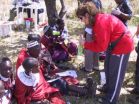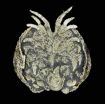(Press-News.org) New York, NY – A protein that normally protects cells from environmental stresses has been shown to interact Marburg virus VP24, allowing the deadly Marburg virus to live longer and replicate better, according to a cell culture study led by scientists at the Icahn School of Medicine at Mount Sinai. The investigators say that deciphering the molecular details of how Marburg virus and the host protein interact may help in developing inhibitors of the virus. Results from the study are published online March 13 in the peer-reviewed journal Cell Reports.
Infections with Marburg virus lead to death in as many as 90% of those infected. Once restricted to Africa, cases of the virus have been identified in travelers from Europe and the United States, making effective prevention and treatment a top biodefense priority.
"Marburg virus has been essentially untreatable," said the study's senior author, Christopher F. Basler, PhD, Professor of Microbiology, at the Icahn School of Medicine at Mount Sinai. "Our study shows that Marburg virus VP24 interacts with the host protein Keap1." Dr. Basler explained that Keap1 regulates the antioxidant response, normally protecting cells from harm. When the virus interacts with Keap1, Marburg virus-infected cells survive longer, facilitating virus growth.
The research builds on previous research in Dr. Basler's lab. Studying Ebola virus, they found that Ebola virus VP24 protein blocks interferon, an important part of the host defense against virus detection. Unlike Ebola virus, a different host protein was shown to interact with Marburg virus.
"If we can develop inhibitors, the virus will die and replicate more slowly – that's the hypothesis that we have now," said Dr. Basler. Next, his laboratory hopes to pursue research and development of targeted therapies.
INFORMATION:
Megan R. Edwards, also from the Icahn School of Medicine at Mount Sinai, was the lead author of this research.
This work was supported by NIH grants AI059536 and AI081914 and DOD Defense Threat Reduction Agency grant HDTRA1-12-1-0051.
About the Mount Sinai Health System:
The Mount Sinai Health System is an integrated health system committed to providing distinguished care, conducting transformative research, and advancing biomedical education. Structured around seven member hospital campuses and a single medical school, the Health System has an extensive ambulatory network and a range of inpatient and outpatient services—from community-based facilities to tertiary and quaternary care.
The System includes approximately 6,600 primary and specialty care physicians, 12-minority-owned free-standing ambulatory surgery centers, over 45 ambulatory practices throughout the five boroughs of New York City, Westchester, and Long Island, as well as 31 affiliated community health centers. Physicians are affiliated with the Icahn School of Medicine at Mount Sinai, which is ranked among the top 20 medical schools both in National Institutes of Health funding and by U.S. News & World Report.
For more information, visit http://www.mountsinai.org.
Find Mount Sinai on:
Facebook
Twitter
YouTube
Mount Sinai scientists discover how Marburg virus grows in cells
Study suggests targeting molecular interaction of virus and host protein may arrest this lethal virus
2014-03-13
ELSE PRESS RELEASES FROM THIS DATE:
Commonly used pain relievers have added benefit of fighting bacterial infection
2014-03-13
Some commonly used drugs that combat aches and pains, fever, and inflammation are also thought to have the ability to kill bacteria. New research appearing online on March 13 in the Cell Press journal Chemistry & Biology reveals that these drugs, better known as NSAIDs, act on bacteria in a way that is fundamentally different from current antibiotics. The discovery could open up new strategies for fighting drug-resistant infections and "superbugs."
"We discovered that some anti-inflammatory drugs used in human and veterinary medicine have weak antibiotic activity and ...
Extinct California porpoise had a unique underbite
2014-03-13
Millions of years ago, the coast of California was home to a species of porpoise distinguished from its living relatives by a lower jaw that extended well beyond the upper, according to researchers who report their findings in the Cell Press journal Current Biology on March 13. In other words, the long-lost porpoise had a rather distinct and unusual underbite.
Careful analysis of the fossilized Semirostrum ceruttii skull also shows that the porpoise's pronounced beak included innervated jaws, which the animal likely used to feel for prey along the ocean floor.
"The ...
Humans' ability to digest milk stems from the advent of cattle domestication in Africa
2014-03-13
Most people lose the ability to digest the milk sugar lactose after weaning, but some populations retain high levels of an enzyme called lactase, which allows them to break down lactose in adulthood. In a study published March 13th in the American Journal of Human Genetics, researchers identified genetic factors associated with lactase persistence in African populations and found that this trait became more prevalent in recent history in conjunction with the introduction and spread of cattle domestication in Africa. The findings provide strong evidence that lactase persistence ...
A versatile mouse that can teach us about many diseases and drugs
2014-03-13
Scientists from the UK and Australia have created a mouse that expresses a fluorescing 'biosensor' in every cell of its body, allowing diseased cells and drugs to be tracked and evaluated in real time and in three dimensions.
This biosensor mimics the action of a target molecule, in this case a protein known as 'Rac', which drives cell movement in many types of cancer. Rac behaves like a switch, oscillating on the molecular level between two states – active or inactive.
When Rac is active, the biosensor picks up chemical cues and glows blue. When Rac is inactive the ...
Penn team links Africans' ability to digest milk to spread of cattle raising
2014-03-13
Babies are born with the ability to digest lactose, the sugar found in milk, but most humans lose this ability after infancy because of declining levels of the lactose-digesting enzyme lactase. People who maintain high levels of lactase reap the nutritive benefits of milk, however, offering a potential evolutionary advantage to lactase persistence, or what is commonly known as lactose tolerance.
A new study led by University of Pennsylvania researchers — constituting the largest investigation ever of lactase persistence in geographically diverse populations of Africans ...
Columbia researchers discover reversible mechanism that increases muscle elasticity
2014-03-13
NEW YORK, NY – How does yoga improve your flexibility? In the Mar 13 cover story of Cell, Columbia University biological sciences professor Julio Fernandez and team report the discovery of a new form of mechanical memory that adjusts the elasticity of muscles to their history of stretching. Using highly sensitive atomic force microscopes, the researchers detected a chemical reaction that increases the elasticity of muscle proteins. Crucially, this reaction targets molecules that have been exposed to a stretching force. This finding changes our understanding of how muscles ...
Researchers identify gene that helps fruit flies go to sleep
2014-03-13
In a series of experiments sparked by fruit flies that couldn't sleep, Johns Hopkins researchers say they have identified a mutant gene — dubbed "Wide Awake" — that sabotages how the biological clock sets the timing for sleep. The finding also led them to the protein made by a normal copy of the gene that promotes sleep early in the night and properly regulates sleep cycles.
Because genes and the proteins they code for are often highly conserved across species, the researchers suspect their discoveries — boosted by preliminary studies in mice — could lead to new treatments ...
Human brains 'hard-wired' to link what we see with what we do
2014-03-13
Your brain's ability to instantly link what you see with what you do is down to a dedicated information 'highway', suggests new UCL-led research.
For the first time, researchers from UCL (University College London) and Cambridge University have found evidence of a specialized mechanism for spatial self-awareness that combines visual cues with body motion.
Standard visual processing is prone to distractions, as it requires us to pay attention to objects of interest and filter out others. The new study has shown that our brains have separate 'hard-wired' systems to visually ...
New view of tumors' evolution
2014-03-13
CAMBRIDGE, MA -- Cancer cells undergo extensive genetic alterations as they grow and spread through the body. Some of these mutations, known as "drivers," help spur cells to grow out of control, while others ("passengers") are merely along for the ride.
MIT cancer biologists at the Koch Institute for Integrative Cancer Research and geneticists from the Broad Institute have now performed the most comprehensive analysis to date of these changes in mice programmed to develop cancer. The team discovered mutations and other genetic disturbances that arise at certain stages ...
Parental care of the young from 450 million years ago
2014-03-13
A portrait of prehistoric parenthood captured deep in the fossil record has been uncovered by an international team of scientists led by University of Leicester geologist Professor David Siveter.
The 'nursery in the sea' has revealed a species new to science – with specimens preserved incubating their eggs together with probable hatched individuals. As a result, the team has named the new species Luprisca incuba after Lucina, goddess of childbirth, and alluding to the fact that the fossils are ancient and in each case the mother was literally sitting on her eggs.
The ...
LAST 30 PRESS RELEASES:
Penn researchers awarded $25M to conduct trial using smartphones to fight heart disease
PCORI awards funding for new patient-centered healthcare research
Exploring the origins of the universe: 145 low-noise amplifiers complete ALMA telescopes
Empress cicada wings help illuminate molecular structure
Using sound waves to detect helium
Time burden in patients with metastatic breast and ovarian cancer from clinic and home demands
Researchers discover bias in AI models that analyze pathology samples
Scientists ID potential way to prevent brain injuries from triggering Alzheimer's
MASTER 2nd Open Call: Execution period kick-off
Algae for health in food and pharma
Advanced microrobots driven by acoustic and magnetic fields for biomedical applications
Chicago health information leader recognized for raising CPR readiness and blood pressure awareness
The Intimate Animal, a new book from Kinsey Institute Executive Director Dr. Justin Garcia
When blue-collar workers lose union protection, they try self-employment
New video dataset to advance AI for health care
MEA-based graph deviation network for early autism syndrome signatures in human forebrain organoids
New modeling approach sheds light on rare gut disease
Study documents potentially hazardous flame retardants in firefighter gear
Can certain bacteria regulate aging of the immune system and its related alterations?
AI model helps diagnose often undetected heart disease from simple EKG
There are fewer online trolls than people think
Cell membrane fluctuations produce electricity
Jeonbuk National University study shows positive parenting can protect adolescents against self-harm
Surface-engineered ZnO nanocrystals to tackle perfluoroalkyl substance contamination
This new understanding of T cell receptors may improve cancer immunotherapies
A new fossil face sheds light on early migrations of ancient human ancestor
A new immunotherapy approach could work for many types of cancer
A new way to diagnose deadly lung infections and save lives
40 percent of MRI signals do not correspond to actual brain activity
How brain-inspired algorithms could drive down AI energy costs
[Press-News.org] Mount Sinai scientists discover how Marburg virus grows in cellsStudy suggests targeting molecular interaction of virus and host protein may arrest this lethal virus



